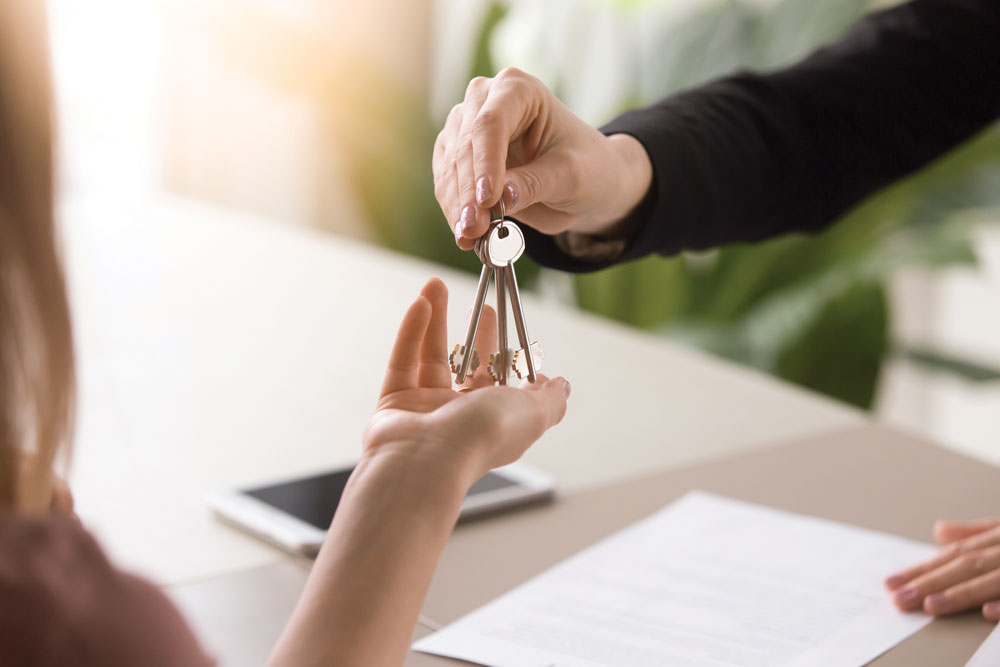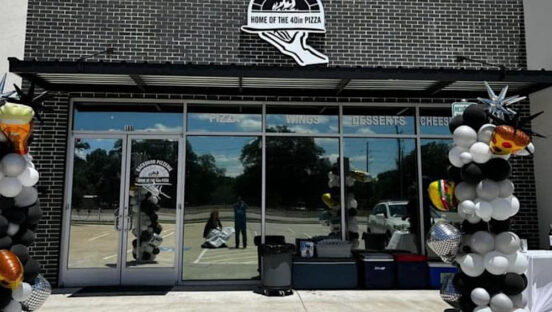Every pizzeria owner should know the value of his or her store. Whether you’re looking to buy or sell, going through a divorce, selling to a key employee, talking to a bank about financing equipment, or planning your estate, you need to be able to define and leverage your shop’s value and sell it for what it’s worth when you’re ready to walk away.
You may have heard various rules of thumb about determining Fair Market Value. Most of these so-called rules are pretty far off the mark—they often just tell you what the seller hopes the business is worth. This article will shed some light on what real pizza businesses sell for, based on actual completed sales of pizza stores over a number of years across many regions.
Related: Want to sell your pizzeria? Here’s how to position it for maximum value
Know Your Multiples
It’s important to take into account customary industry practices for valuing businesses. When an appraiser looks at a business, he will take into account the way that particular industry typically values itself, since that will be important to a buyer. How does the pizza industry typically value these kinds of businesses? What are the common practices of business brokers and the legitimate rules of thumb that are used?
The approach of using a multiple has value. We often hear that a pizza store sold for 2X earnings or that “my store is worth 3X cash flow.” In the pizza industry, most business brokers are referring to Price divided by Seller’s Discretionary Earnings (SDE) when talking about a business selling for 2X or 3X earnings.
Knowing what you are multiplying is crucial! For example, 5X Net Income Before Taxes might be a realistic price (depending on many things), while 5X SDE is just a daydream. To understand the multiples I will use later on, it is important to be clear on what they multiply. I’ll be using these two:
1. Multiple of Sales: Sales after all discounts, not including sales tax.
2. Multiple of Seller’s Discretionary Earnings (SDE): The cash and economic benefits that one owner takes from the business, such as W-2 wages, S-Corp dividends or paying your kid’s smartphone bills, plus noncash expenses and interest.
For example:
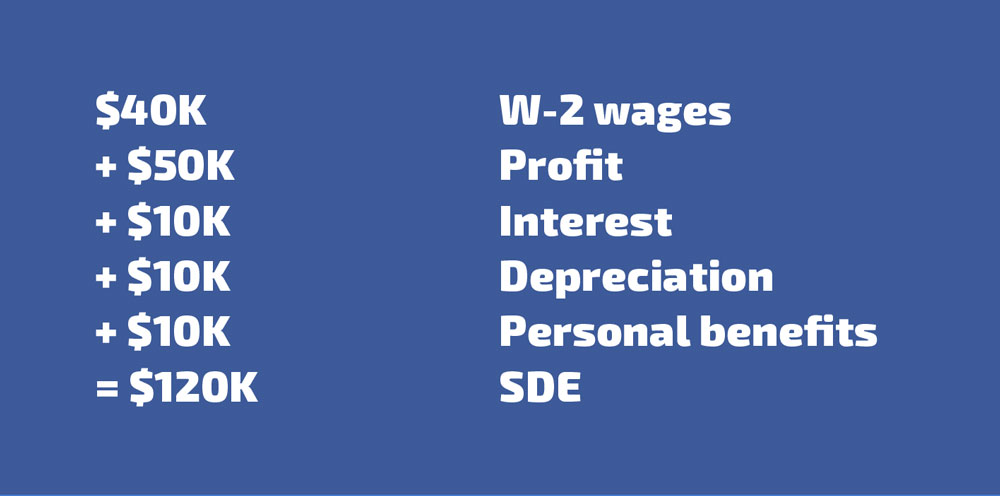
If the business sold for $240,000, that would value the business at a Price/SDE multiple of 200% (240/120 = 200%). If the gross sales were $800,000 and the selling price was $240,000, the Price/Sales multiple would be 30% (240/800=30%).
If there is a spouse or partner in the business, you would count what they make, too, but then you must add back what it would cost to hire someone to perform the duties that spouse or partner performs, whether the amount you have to add back is greater or lesser than what that spouse or partner earns.
Determining a Realistic Value
So what is a realistic way to determine how much a pizzeria actually sells for? What are the median and range of values? What are the key variables that can be shown to move the multiples?
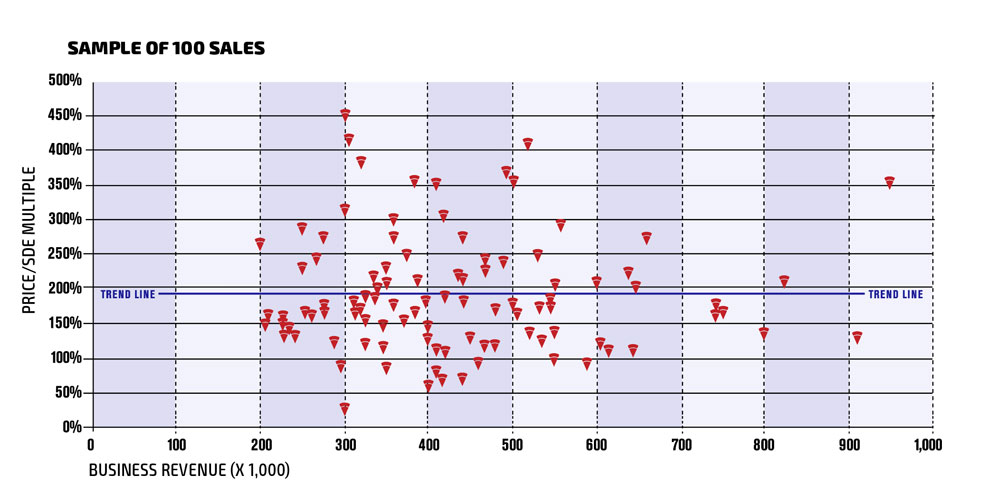
Most people are comfortable with what an “average” is. Fewer are ready to use the “median,” but it’s important in statistics. In a sample of values, the median is the middle point of a data set, where there are as many greater reported values as lesser ones. It is less impacted by values at the extremes than an average. In this case, the “median” multiple will be the one where as many stores sold for a multiple higher than the median as sold for a lower multiple.
Using a database I subscribe to, I pulled a sample of 100 completed sales of profitable pizza stores with gross revenue between $200,000 and $1,000,000. For that sample
of stores, the median values were pretty typical of independent operators:

Using the actual selling prices for these businesses (not including inventory, prepaid deposits, etc.), the median values for the multiples of the selling prices were:

The “median” means that half of these 100 stores sold for more than 1.76X SDE, and half sold for less than 1.76X SDE.
Now perhaps we know the “typical” price, but what is the variation in the statistics, and what factors might influence what a business sells for? For the sample I used, here is a breakdown of the number of transactions in various brackets of value for Price/SDE:
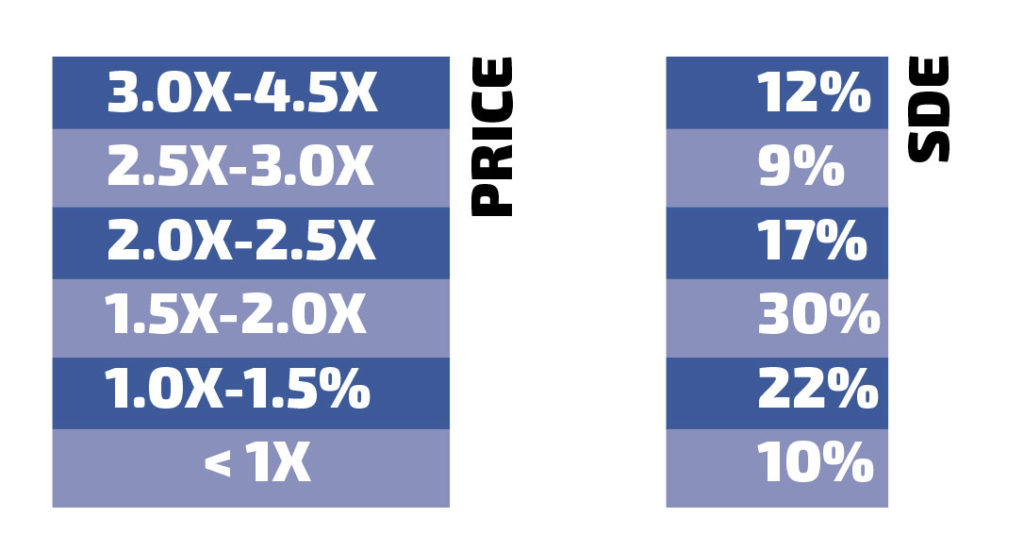
What does this mean? First of all, among these brackets, the single most likely range for a sale is between 1.5X and 2.0X SDE. Yes, some pizzerias sell for 3X SDE or more, but only some, while about as many sell for less than 1X SDE.
The trend line in the Sample Sales chart above shows that the prices paid for pizzerias—as described by the Price/SDE multiple on the left—did not change as a function of the size of the business revenue (shown on the bottom) within this range. In other words, it’s not necessarily the size of the business that causes one business to sell for more than another (higher multiple, not higher price). So what is the reason?
For a business to sell for more than the median value or more than some other businesses, one might look for reasons why the opportunity was better than average. For example, the company’s capacity to grow, a steady growth rate, an advantageous lease, newer equipment, or a location where there’s no competition—all of these factors might lower risk for a buyer and increase what the buyer might be willing to pay.
When appraising a specific business, I look at these multiples and others, but I also consider additional approaches to valuation, such as discounted future earnings or liquidation value, and then apply variables. In the end, though, appraisals do not wander out of the statistical range. For pizza stores, as shown in the stats in the sample above, two-thirds of all sales are made between 1X and 2.5X SDE, and very few go above 3.5X SDE. (In a separate review of sales of larger stores, none of the $1 million-plus stores I looked at were sold above 3X SDE.)
Preparing to Sell
Why don’t businesses sell? What can or should a business owner do to make the most of a contemplated sale in the future? The data tells us that a large majority of small businesses listed for sale never actually get purchased, often because the asking price is simply too high. Misleading rules of thumb may make some sellers unwilling to take offers that are, in fact, good offers. In other cases, business information is incomplete or less than transparent.
If you’re looking to sell your pizzeria, you should spend several years preparing for the sale. Recognize that a buyer will be looking over your books and will likely be at least considering a multiple of sales and multiple of SDE as a way of evaluating price. And they will get this information from your tax returns. Anything else is just hot air. So you’ll need to do the following:
1. Declare your sales.
2. Clean up your expenses—for example, stop deducting questionable stuff. Bite the bullet and show the highest taxable income you can for at least a couple of years before the sale.
3. Make sure your lease is in good order, with some time still to run or a solid option in place.
4. Maintain your equipment.
5. Show a rising sales trend. Buyers do not want to “catch a falling knife.” It would be better to get 2.4X $70K based on rising sales than to cut marketing and show $80K on falling or flat sales but only receive 1.4X SDE.
For the record, nothing in this article should be viewed as an appraisal of any one specific pizza business. But I hope you find it interesting and useful as you prepare to sell your own pizza shop.
Steve Hitchcock is a broker licensed in Colorado since 2007 who works in business brokerage with Touchstone Business Advisors. In 2010, he earned the CBA (Certified Business Appraiser) designation with the Institute of Business Appraisers and is currently active as a business broker and performing appraisals of small businesses for various purposes. He has owned pizza restaurants in Steamboat Springs since 1999. He can be reached at steve-hitchcock@comcast.net or 970-819-9789.

